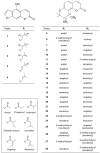Comparative Analysis of Coumarin Profiles in Different Parts of Peucedanum japonicum and Their Aldo-Keto Reductase Inhibitory Activities
- PMID: 36364218
- PMCID: PMC9657185
- DOI: 10.3390/molecules27217391
Comparative Analysis of Coumarin Profiles in Different Parts of Peucedanum japonicum and Their Aldo-Keto Reductase Inhibitory Activities
Abstract
Peucedanum japonicum (Umbelliferae) is widely distributed throughout Southeast Asian countries. The root of this plant is used in traditional medicine to treat colds and pain, whereas the young leaves are considered an edible vegetable. In this study, the differences in coumarin profiles for different parts of P. japonicum including the flowers, roots, leaves, and stems were compared using ultra-performance liquid chromatography time-of-flight mass spectrometry. Twenty-eight compounds were tentatively identified, including three compounds found in the genus Peucedanum for the first time. Principal component analysis using the data set of the measured mass values and intensities of the compounds exhibited distinct clustering of the flower, leaf, stem, and root samples. In addition, their anticancer activities were screened using an Aldo-keto reductase (AKR)1C1 assay on A549 human non-small-cell lung cancer cells and the flower extract inhibited AKR1C1 activity. Based on these results, seven compounds were selected as potential markers to distinguish between the flower part versus the root, stem, and leaf parts using an orthogonal partial least-squares discriminant analysis. This study is the first to provide information on the comparison of coumarin profiles from different parts of P. japonicum as well as their AKR1C1 inhibitory activities. Taken together, the flowers of P. japonicum offer a new use related to the efficacy of overcoming anticancer drug resistance, and may be a promising source for the isolation of active lead compounds.
Keywords: Aldo–keto reductases; Peucedanum japonicum; coumarin.
Conflict of interest statement
The authors declare no conflict of interest.
Figures





References
-
- Morioka T., Suzui M., Nabandith V., Inamine M., Aniya Y., Nakayama T., Ichiba T., Mori H., Yoshimi N. The modifying effect of Peucedanum japonicum, a herb in the Ryukyu Islands, on azoxymethane-induced colon preneoplastic lesions in male F344 rats. Cancer Lett. 2004;205:133–141. doi: 10.1016/j.canlet.2003.10.002. - DOI - PubMed
-
- Ikeshiro Y., Mase I., Tomita Y. Dihydropyranocoumarins from roots of Peucedanum japonicum. Phytochemistry. 1992;31:4303–4306. doi: 10.1016/0031-9422(92)80463-O. - DOI
-
- Yang E.J., Kim S.S., Oh T.H., Song G., Kim K.N., Kim J.Y., Lee N.H., Hyun C.G. Peucedanum japonicum and Citrus unshiu essential oils inhibit the growth of antibiotic-resistant skin pathogens. Ann. Microbiol. 2009;59:623–628. doi: 10.1007/BF03175155. - DOI
MeSH terms
Substances
Grants and funding
LinkOut - more resources
Full Text Sources
Other Literature Sources
Medical
Research Materials

